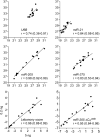MiR-205 and MiR-375 microRNA assays to distinguish squamous cell carcinoma from adenocarcinoma in lung cancer biopsies
- PMID: 25695220
- PMCID: PMC5819754
- DOI: 10.1097/JTO.0000000000000423
MiR-205 and MiR-375 microRNA assays to distinguish squamous cell carcinoma from adenocarcinoma in lung cancer biopsies
Abstract
Introduction: Identification of adenocarcinoma (AC) and squamous cell carcinoma (SCC) histology of non-small-cell lung cancer (NSCLC) in biopsies is clinically important but can be inaccurate by routine histopathologic examination. We quantify this inaccuracy at a cancer center, and evaluate the utility of a microRNA-based method to histotype AC/SCC in biopsies.
Methods: RNA was extracted from tissue sections with greater than 90% tumor content that were macro- or micro-dissected from formalin-fixed, paraffin-embedded biopsy specimens. MicroRNAs in RNA from the biopsies and from resected tumors were quantified by TaqMan reverse transcription-polymerase chain reaction assays and normalized against the RNU6B housekeeping RNA. Publicly available microRNA expression datasets were examined.
Results: NSCLC subtyping of small biopsy specimens by routine histopathologic examination either failed or mistyped the histology of 21% of 190 cases. Using 77 resectates, an reverse transcription-polymerase chain reaction-based assay of microRNAs miR-21, miR-205, and miR-375 was developed to identify AC and SCC subtypes of NSCLC. This method identified the AC/SCC histotypes of 25 biopsies with an accuracy of 96%, and correctly histotyped all 12 cases for which the histology had been mistyped by routine histopathologic examination of the biopsy. Examination of publicly available datasets identified miR-205 and miR-375 as microRNAs with the best ability to histotype AC and SCC, and that levels of the two microRNAs in AC or SCC are unaffected by the pathologic stage of the tumor or the age or race of the patient.
Conclusions: Histotypic microRNA assays can aid the subtyping of NSCLC biopsies as AC or SCC by standard histopathologic methods.
Conflict of interest statement
Figures




Comment in
-
MicroRNA Assays for Diagnosis Lung Cancer Biopsy.J Thorac Oncol. 2015 Jun;10(6):e52-3. doi: 10.1097/JTO.0000000000000528. J Thorac Oncol. 2015. PMID: 26001154 No abstract available.
-
Reply to "MiR-205 and miR-375 microRNA Assays to Distinguish Squamous Cell Carcinoma From Adenocarcinoma in Lung Cancer Biopsies".J Thorac Oncol. 2015 Jun;10(6):e53. doi: 10.1097/JTO.0000000000000539. J Thorac Oncol. 2015. PMID: 26001155 No abstract available.
Similar articles
-
Prognostic value of microRNA expression in operable non-small cell lung cancer patients.Br J Cancer. 2014 Feb 18;110(4):991-1000. doi: 10.1038/bjc.2013.786. Epub 2014 Jan 21. Br J Cancer. 2014. PMID: 24448358 Free PMC article.
-
Two microRNA panels to discriminate three subtypes of lung carcinoma in bronchial brushing specimens.Am J Respir Crit Care Med. 2012 Dec 1;186(11):1160-7. doi: 10.1164/rccm.201203-0534OC. Epub 2012 Oct 4. Am J Respir Crit Care Med. 2012. PMID: 23043084
-
Regulation of TPD52 by antitumor microRNA-218 suppresses cancer cell migration and invasion in lung squamous cell carcinoma.Int J Oncol. 2016 Nov;49(5):1870-1880. doi: 10.3892/ijo.2016.3690. Epub 2016 Sep 13. Int J Oncol. 2016. PMID: 27633630 Free PMC article.
-
Gene expression profiling for early-stage NSCLC.Am J Clin Oncol. 2015 Feb;38(1):103-7. doi: 10.1097/COC.0b013e31828d95d8. Am J Clin Oncol. 2015. PMID: 23608827 Review.
-
Identification of differentially expressed circulating serum microRNA for the diagnosis and prognosis of Indian non-small cell lung cancer patients.Curr Probl Cancer. 2020 Aug;44(4):100540. doi: 10.1016/j.currproblcancer.2020.100540. Epub 2020 Jan 23. Curr Probl Cancer. 2020. PMID: 32007320 Review.
Cited by
-
Molecular profiling of lung adenosquamous carcinoma: hybrid or genuine type?Oncotarget. 2015 Sep 15;6(27):23905-16. doi: 10.18632/oncotarget.4163. Oncotarget. 2015. PMID: 26068980 Free PMC article.
-
MiRNAs in Lung Adenocarcinoma: Role, Diagnosis, Prognosis, and Therapy.Int J Mol Sci. 2023 Aug 27;24(17):13302. doi: 10.3390/ijms241713302. Int J Mol Sci. 2023. PMID: 37686110 Free PMC article. Review.
-
Preoperative chemoradiotherapy for rectal cancer: the sensitizer role of the association between miR-375 and c-Myc.Oncotarget. 2017 Jul 19;8(47):82294-82302. doi: 10.18632/oncotarget.19393. eCollection 2017 Oct 10. Oncotarget. 2017. PMID: 29137264 Free PMC article.
-
A prediction model for distinguishing lung squamous cell carcinoma from adenocarcinoma.Oncotarget. 2017 Apr 11;8(31):50704-50714. doi: 10.18632/oncotarget.17038. eCollection 2017 Aug 1. Oncotarget. 2017. PMID: 28881596 Free PMC article.
-
MiR-205 as a promising biomarker in the diagnosis and prognosis of lung cancer.Oncotarget. 2017 Aug 14;8(54):91938-91949. doi: 10.18632/oncotarget.20262. eCollection 2017 Nov 3. Oncotarget. 2017. PMID: 29190887 Free PMC article.
References
-
- Scagliotti G, Hanna N, Fossella F, et al. The differential efficacy of pemetrexed according to NSCLC histology: a review of two Phase III studies. Oncologist. 2009;14:253–263. - PubMed
-
- Gressett SM, Shah SR. Intricacies of bevacizumab-induced toxicities and their management. Ann Pharmacother. 2009;43:490–501. - PubMed
-
- Travis WD, Brambilla E, Riely GJ. New Pathologic Classification of Lung Cancer: Relevance for Clinical Practice and Clinical Trials. Journal of clinical oncology: official journal of the American Society of Clinical Oncology. 2013 - PubMed
-
- Sigel CS, Moreira AL, Travis WD, et al. Subtyping of non-small cell lung carcinoma: a comparison of small biopsy and cytology specimens. Journal of thoracic oncology: official publication of the International Association for the Study of Lung Cancer. 2011;6:1849–1856. - PubMed
-
- Rekhtman N, Ang DC, Sima CS, et al. Immunohistochemical algorithm for differentiation of lung adenocarcinoma and squamous cell carcinoma based on large series of whole-tissue sections with validation in small specimens. Modern pathology: an official journal of the United States and Canadian Academy of Pathology, Inc. 2011;24:1348–1359. - PubMed
MeSH terms
Substances
Grants and funding
LinkOut - more resources
Full Text Sources
Other Literature Sources
Medical
Research Materials

